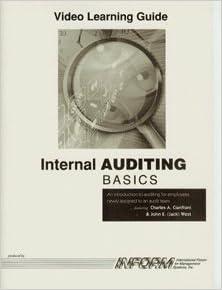Question
Prime Essentials Ltd. is a small private corporation. The owner plans to approach the bank for an additional loan or a line of credit to
Prime Essentials Ltd. is a small private corporation. The owner plans to approach the bank for an additional loan or a line of credit to facilitate expansion. The company bookkeeper, after discussion with the owner of the company, has prepared the following draft SFP for the fiscal year ended 30 September 20X3, the companys first full year of operations:
| PRIME ESSENTIALS LTD. Statement of Financial Position | |
|---|---|
| Year ended 30 September 20X3 | |
| Assets | |
| Cash in the bank | $ 12,000 |
| Patent | 30,000 |
| Goodwill | 50,000 |
| Equipment | 120,000 |
| Amounts owed by customers | 32,000 |
| Stocks and bonds owned by the company | 10,000 |
| Total | $254,000 |
| Financing Sources for Assets | |
| Amounts owed to suppliers | 28,000 |
| Amount owed to owner for automobile expenses | 6,000 |
| Amount owed to owners brother-in-law | 20,000 |
| Amount owed to bank | 26,000 |
| Earnings accumulated in the business | 27,000 |
| Shares paid for by owner | 60,000 |
| Cash flow from used-up portion of equipment | 24,000 |
| Increases in value | 63,000 |
| Total | $254,000 |
The bookkeeper has provided some notes on the amounts included in the draft SFP:
The owner invested $60,000 of his own money to start the business.
The patent was purchased from the owners brother-in-law for $17,000. The owner believes that the patent could easily be sold for $30,000, and probably more.
The equipment is being depreciated at the same rate as allowed for income tax. Depreciation represents a source of financing for the company because it is added back to net income and increases the operating cash flow.
The owner uses his personal automobile for occasional business errands. He estimates that the company owes him $6,000 for his use of the car.
Because the business has been profitable, the owner estimates that he could sell the company at a $50,000 premium, thereby almost doubling his initial investment after only one year.
The bank gave a five-year loan to the company, with the provision that the company had to maintain a 25% compensating balance in its cash account until the loan is repaid.
The company holds publicly traded shares in other companies. The value of these securities was $10,000 when the owners brother-in-law gave them to the company as a loan on 1 April 20X3. On 30 September 20X3, their market value was $14,000. The company is free to sell the securities, but $10,000 plus one-half of any proceeds above $10,000 must be passed on to the brother-in-law. The brother-in-law also lent $10,000 cash to the company, repayable on demand.
One of the customers is a bit unsteady, financially. That customer owes $3,000.
Required:
Redraft the SFP. Provide an explanation for each change you make. Explain any note disclosures you think are needed.
Step by Step Solution
There are 3 Steps involved in it
Step: 1

Get Instant Access to Expert-Tailored Solutions
See step-by-step solutions with expert insights and AI powered tools for academic success
Step: 2

Step: 3

Ace Your Homework with AI
Get the answers you need in no time with our AI-driven, step-by-step assistance
Get Started


